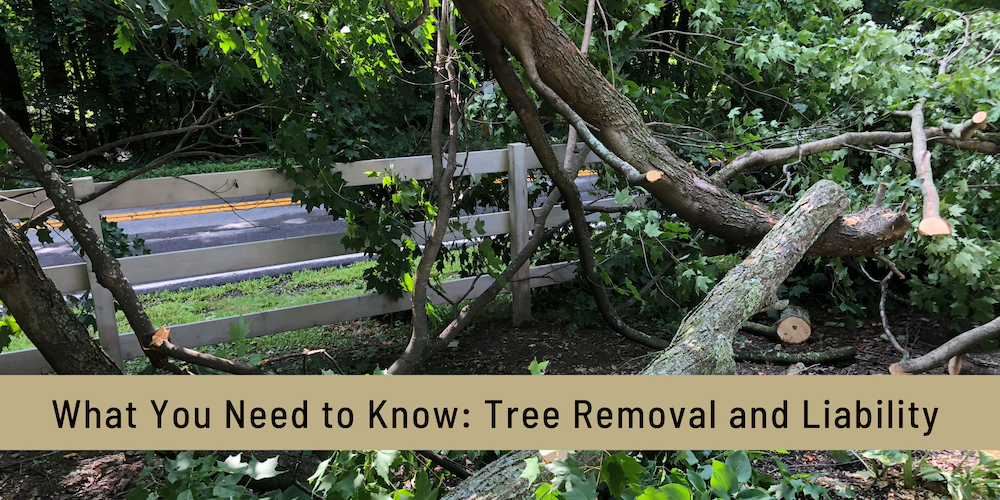
Trees are an important part of our natural environment, but must be properly maintained or they can pose a risk to nearby buildings and properties.
In this blog post, we will answer some of the most common questions people have about tree removal and liability for damage to neighboring properties.
Who is responsible for tree removal cost?
The responsibility for the cost of removing a tree depends on a number of factors, including
- the reason for the removal
- the location of the tree.
If the tree is on private property and needs to be removed for reasons of safety or health, the property owner is generally responsible for the cost of removal. If the tree is located on public property, such as a sidewalk or park, the cost of removal may be the responsibility of the municipality or other public agency.
I’m not sure a tree is mine, how can I find out?
The University of Tennessee Extension Institute of Agriculture published an article on Tree Owner’s Rights and Responsibilities. You can view it here.
What steps should I take to prevent tree-related damage to my neighbor’s property?
To prevent tree-related damage to your neighbor’s property, you should regularly inspect your trees for signs of disease or damage, and have any necessary maintenance or pruning done by a qualified professional. You should also be aware of any potential risks posed by your trees, such as overhanging branches or weak roots, and take steps to mitigate those risks.
Can my neighbor make me remove my tree if it is causing damage to their property?
If a tree on your property is causing damage to your neighbor’s property, your neighbor may ask you to remove the tree. In some cases, your neighbor may be able to take legal action to compel you to remove the tree if it is posing a significant risk or if it is causing significant damage to their property.
What types of damage can a tree cause to neighboring properties?
Trees can cause a range of damage to neighboring properties, including damage to buildings, fences, and other structures, as well as damage to landscaping, vehicles, and other property.
In extreme cases, falling trees can also cause injury or death.
What happens if a tree falls on my neighbor’s property and causes damage?
If a tree on your property falls and causes damage to your neighbor’s property, you may be held liable for the cost of the damage.
Liability will depend on a number of factors, including the cause of the tree’s fall and whether or not you knew or should have known that the tree was at risk of falling.
Can my neighbor sue me if my tree damages their property?
Yes, your neighbor may be able to sue you if your tree damages their property.
However, liability will depend on a number of factors, including the cause of the tree’s fall and whether or not you knew or should have known that the tree was at risk of falling.
If the tree fell due to natural causes, such as a storm or other act of nature, you may not be held liable.
However, if the tree fell because it was diseased, damaged, or otherwise unstable, and you knew or should have known about the risk, you may be held liable for the cost of the damage.
It’s important to note that liability for tree-related damage can be a complex issue, and may depend on local laws and regulations, as well as the specific circumstances of each case.
If you are facing a legal dispute related to tree-related damage, it’s recommended to consult with a qualified legal expert.
Is it necessary to obtain permission from my neighbor before removing a tree?
In most cases, you do not need to obtain permission from your neighbor before removing a tree on your property. However, it is a good idea to inform your neighbor of your plans and discuss any potential concerns they may have.
What are the legal requirements for tree removal in my area?
The legal requirements for tree removal vary depending on the location and the specific circumstances. In general, it is a good idea to check with your local municipality or other relevant authorities to find out what the legal requirements are in your area.
To find out more information about the specific regulations in your area, we recommend contacting your local municipality. Here are some contact details for local municipalities:
If I own a home in Sevier County, who can help me with tree removal?
The city of Gatlinburg provided a list of tree trimming and removal experts, you can find it here.
As a property owner, it’s important to take steps to maintain and manage your trees to prevent damage to neighboring properties and minimize liability for tree-related accidents.
Regular inspection and maintenance by qualified professionals can help identify and address potential risks posed by your trees, and communication with your neighbors can help avoid disputes and legal action. If you are facing a legal dispute related to tree-related damage, it’s recommended to seek legal advice to better understand your rights and responsibilities.
By being proactive and responsible, you can enjoy the benefits of trees on your property while minimizing the risks and liabilities they may pose.
*It’s important to note that the information provided in this blog post is for general informational purposes only and should not be construed as legal advice. While we have made every effort to provide accurate and up-to-date information, we cannot guarantee the accuracy or completeness of the information provided.
